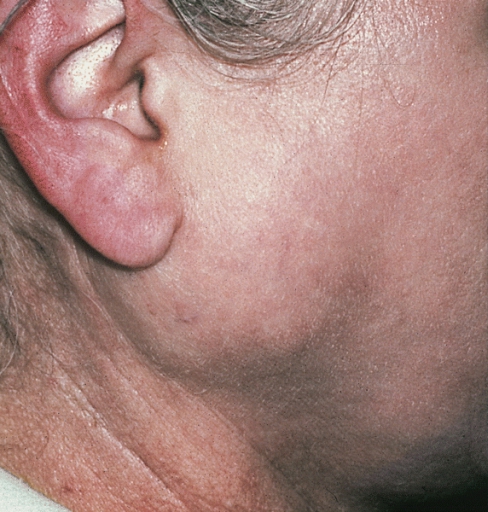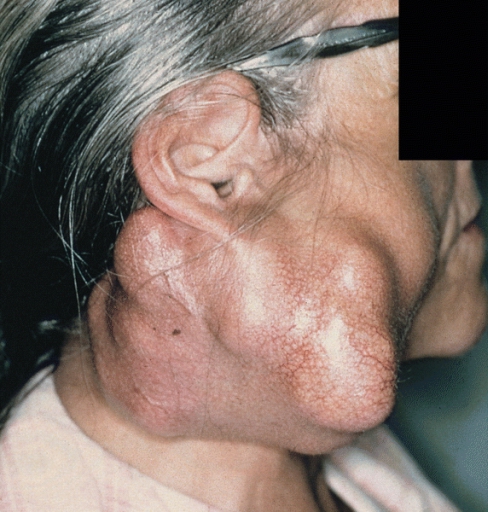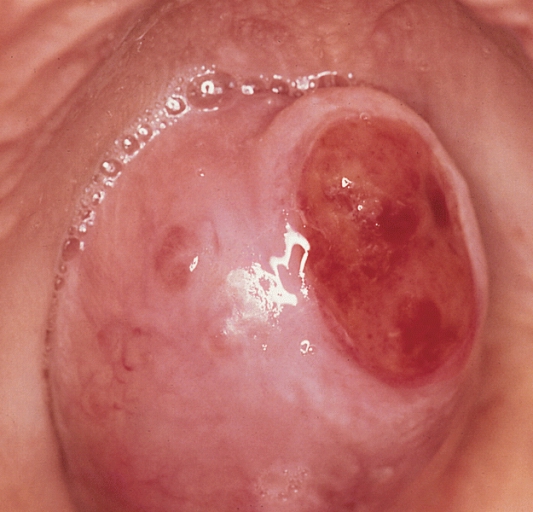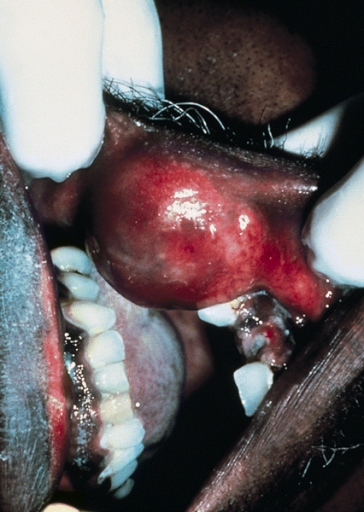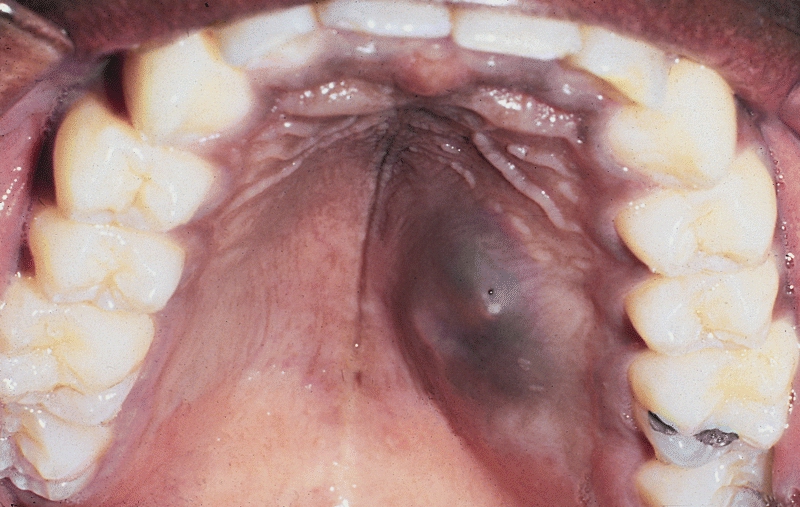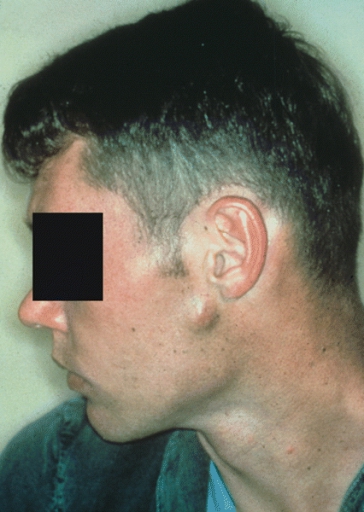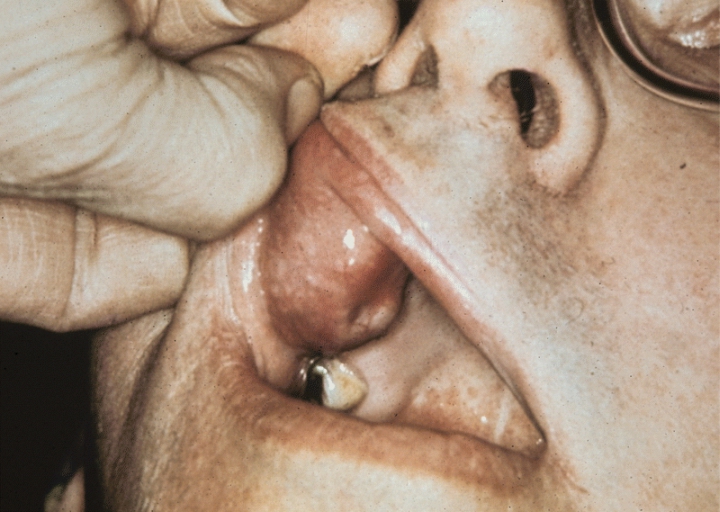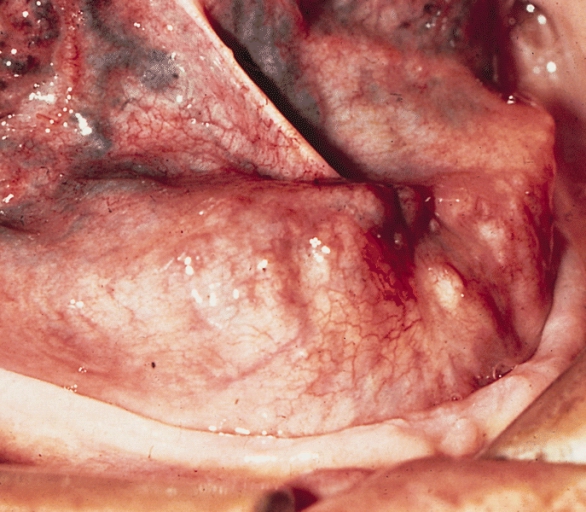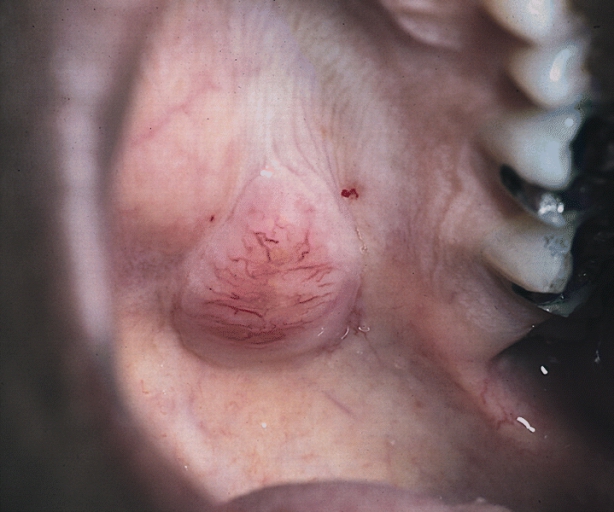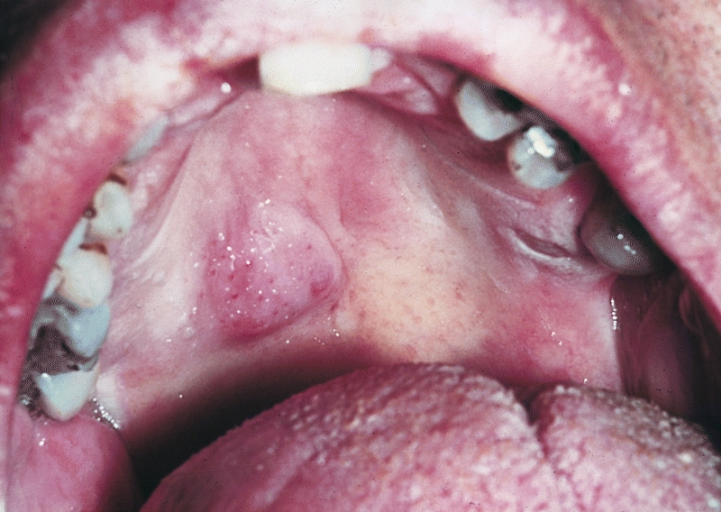Salivary gland tumor
| Salivary gland cancer | |
| Classification and external resources | |

| |
|---|---|
| The major salivary glands: the Parotid gland (1), where most salivary gland tumors form, the Submandibular gland (2), and the Sublingual gland (3). | |
| ICD-10 | C07-C08, D11 |
| ICD-9 | 142, 210.2 |
| MedlinePlus | 001040 |
| MeSH | D012468 |
For patient information, click here
|
Salivary gland tumor Microchapters |
|
Diagnosis |
|---|
|
Treatment |
|
Case Studies |
|
Salivary gland tumor On the Web |
|
American Roentgen Ray Society Images of Salivary gland tumor |
Editor-In-Chief: C. Michael Gibson, M.S., M.D. [1]
Synonyms and keywords: salivary gland tumor, salivary gland cancer, salivary gland neoplasia, salivary gland neoplasm, parotid tumor, parotid cancer, parotid neoplasia, parotid neoplasm, parotid gland tumor, parotid gland cancer, parotid gland neoplasia, parotid gland neoplasm
Overview
Tumors of the salivary glands (salivary gland neoplasm) are usually benign, but may be malignant. The most common type of benign tumor is pleomorphic adenoma, followed by Warthin's tumor. The most common malignant tumor is mucoepidermoid carcinoma. Eighty percent begin in the parotid gland.[1] Salivary gland cancer is a cancer that forms in tissues of a salivary gland. The salivary glands are classified as major and minor. The major salivary glands consist of the parotid, submandibular, and sublingual glands. The minor glands include small mucus-secreting glands located throughout the palate, nasal and oral cavity.[2] Salivary gland cancer is rare, with 2% of head and neck tumors forming in the salivary glands, the majority in the parotid.[3]
Classification
Salivary gland neoplasms are classified by the World Health Organization as primary or secondary, benign or malignant, and by tissue of origin.[4] This system defines five broad categories of salivary gland neoplasms:[5]
- malignant epithelial tumors (e.g. acinic cell carcinoma, mucoepidermoid carcinoma and adenoid cystic carcinoma, salivary duct carcinoma)
- benign epithelial tumors (e.g. pleomorphic adenoma, myoepithelioma and Warthin tumour, sebaceous lymphadenoma)
- soft tissue tumors (Hemangioma)
- hematolymphoid tumors (e.g. Hodgkin lymphoma)
- secondary tumors.
Risk Factors
- Older age
- Radiation therapy to the head or neck
- Occupational exposure
Differential Diagnosis
In alphabetical order the different tumor types that must be differentiated from each other include the folloiwng: [6] [7]
Benign
- Lymphoepithelial lesion
- Monomorphic adenoma
- Pleomorphic adenoma
- Sebaceous tumor
Malignant
- Adenocarcinoma
- Adenoid cystic carcinoma
- Malignant mixed tumor
- Mucoepidermoid carcinoma
- Squamous Cell Carcinoma
Diagnosis
Symptoms
The most common symptom of major salivary gland cancer is a painless lump in the affected gland, sometimes accompanied by paralysis of the facial nerve. A full list of symptoms includes the following:
- Fluid draining from the ear
- Pain in the gland
- Numbness overlying the gland
- Dysphagia (trouble swallowing)
- Painless or painful lump
Physical Examination
Neck
-
SALIVARY GLANDS: MIXED TUMOR OF PAROTID. The pre-auricular mass had enlarged to this size over a period of 5 years.(Courtesy of Dr. Charles E. Tomich, Indianapolis, IN.)
-
SALIVARY GLANDS: RECURRENT MIXED TUMOR. The characteristic multinodular growth of recurrent mixed tumor is obvious inthis parotid mass. (Courtesy of Dr. Lewis R. Eversole, Los Angeles, CA.)
-
SALIVARY GLANDS: MIXED TUMOR OF PALATE. Most mixed tumors involve only one side of the palate because there are few minor glands in the midline. In this case the tumor appears symmetrical on either side of the midline. Large intraoral tumors are susceptible to trauma-related ulceration, as illustrated here. (Courtesy of F. J.Kratochvil, Bethesda, MD.)
-
SALIVARY GLANDS: CANALICULAR ADENOMA. The upper lip is the site for over 70% of canalicular adenomas.
-
SALIVARY GLANDS: MUCOEPIDERMOID CARCINOMA OF PALATE. These tumors frequently are slightly raised, fluctuant, bluish discolorations of the palatal mucosa that are clinically thought to represent mucous escapereactions.
-
SALIVARY GLANDS: ACINIC CELL ADENOCARCINOMA: CLINICAL PRESENTATION: A 2.0-cm raised subcutaneous nodule just anterior to the lower portion of the ear is a common clinical presentation for acinic cell adenocarcinoma. The tumor is in the superficial lobe of the left parotid gland of this 24-year-old man.
-
SALIVARY GLANDS: ACINIC CELL ADENOCARCINOMA: CLINICAL PRESENTATION. The upper lip, or any other intra oral site, is an uncommon location for acinic cell adenocarcinoma.
-
SALIVARY GLANDS: ADENOID CYSTIC CARCINOMA. This sublingual gland tumor slowly enlarged to produce a large, lobulated mass in the anterior floor of the mouth. The oral mucosa is intact.
-
SALIVARY GLANDS: POLYMORPHOUS LOW-GRADE ADENOCARCINOMA. This tumor presented as a well-circumscribed, slow growing mass at the junction of the hard and soft palates. Pronounced telangiectasia of the overlying mucosa is evident. (Courtesy of Dr. Richard Canaan, Ocean Springs,MS.)
-
SALIVARY GLANDS: NECROTIZING SIALOMETAPLASIA. Swelling, as shown in this photograph of a palatal lesion, is a frequent initial clinical presentation. Many of the swellings subsequently ulcerate. (Courtesy of Dr. Ralph Correll, LosAngeles, CA.)
Treatment
Stage I Salivary Gland Cancer
Treatment for stage I salivary gland cancer depends on whether the cancer is low-grade (slow growing) or high-grade (fast growing). If the cancer is low-grade, treatment may include the following:
- Surgery with or without radiation therapy.
- Fast neutron radiation therapy.
If the cancer is high-grade, treatment may include the following:
- Surgery with or without radiation therapy.
- A clinical trial of chemotherapy.
- A clinical trial of a new local therapy.
Stage II Salivary Gland Cancer
Treatment for stage II salivary gland cancer depends on whether the cancer is low-grade (slow growing) or high-grade (fast growing). If the cancer is low-grade, treatment may include the following:
- Surgery with or without radiation therapy.
- Radiation therapy.
- Chemotherapy.
If the cancer is high-grade, treatment may include the following:
- Surgery with or without radiation therapy.
- Fast neutron or photon-beam radiation therapy.
- A clinical trial of radiation therapy and/or radiosensitizers.
- A clinical trial of chemotherapy.
Stage III Salivary Gland Cancer
Treatment for stage III salivary gland cancer depends on whether the cancer is low-grade (slow growing) or high-grade (fast growing). If the cancer is low-grade, treatment may include the following:
- Surgery with or without lymphadenectomy. Radiation therapy may also be given after surgery.
- Radiation therapy
- Fast neutron radiation therapy to lymph nodes with cancer
- Chemotherapy
If the cancer is high-grade, treatment may include the following:
- Surgery with or without lymphadenectomy. Radiation therapy may also be given after surgery.
- Fast neutron radiation therapy.
- Radiation therapy as palliative therapy to relieve symptoms and improve quality of life.
- A clinical trial of radiation therapy and/or radiosensitizers.
- A clinical trial of chemotherapy.
Stage IV Salivary Gland Cancer
Treatment of stage IV salivary gland cancer may include the following:
- Fast neutron or photon-beam radiation therapy.
- A clinical trial of chemotherapy with or without radiation therapy.
Radiation Therapy
Fast neutron therapy has been used successfully to treat salivary gland tumors,[8] and has shown to be significantly more effective than photons in studies treating unresectable salivary gland tumors.[9][10]
References
- ↑ "ACS :: What Is Salivary Gland Cancer?".
- ↑ Shah, p. 240
- ↑ Harari, p. 89
- ↑ IARC, p. 210
- ↑ IARC, p. 210
- ↑ Sailer, Christian, Wasner, Susanne. Differential Diagnosis Pocket. Hermosa Beach, CA: Borm Bruckmeir Publishing LLC, 2002:77 ISBN 1591032016
- ↑ Kahan, Scott, Smith, Ellen G. In A Page: Signs and Symptoms. Malden, Massachusetts: Blackwell Publishing, 2004:68 ISBN 140510368X
- ↑ Douglas JD, Koh WJ , Austin-Seymour, M, Laramore GE. Treatment of Salivary Gland Neoplasms with fast neutron Radiotherapy. Arch Otolaryngol Head Neck Surg Vol 129 944-948 Sep 2003
- ↑ Laramore GE, Krall JM, Griffin TW, Duncan W, Richter MP, Saroja KR, Maor MH, Davis LW. Neutron versus photon irradiation for unresectable salivary gland tumors: final report of an RTOG-MRC randomized clinical trial. Int J Radiat Oncol Biol Phys. 1993 Sep 30;27(2):235-40.
- ↑ Krüll A, Schwarz R, Engenhart R, et al.: European results in neutron therapy of malignant salivary gland tumors. Bull Cancer Radiother 83 (Suppl): 125-9s, 1996
